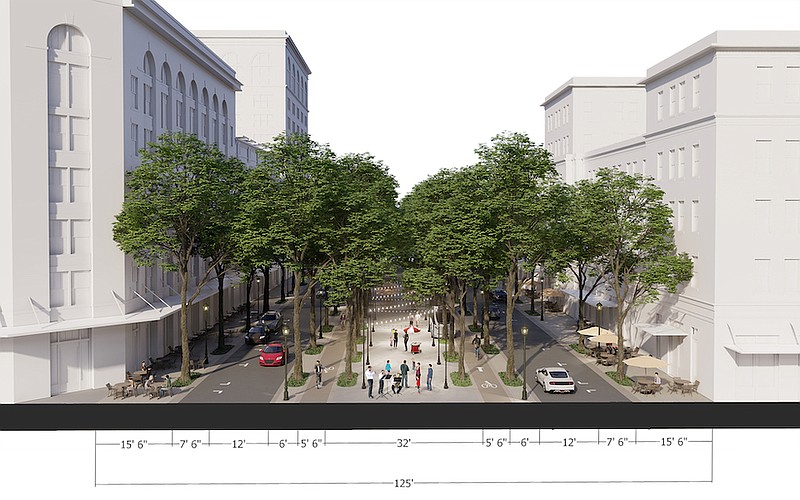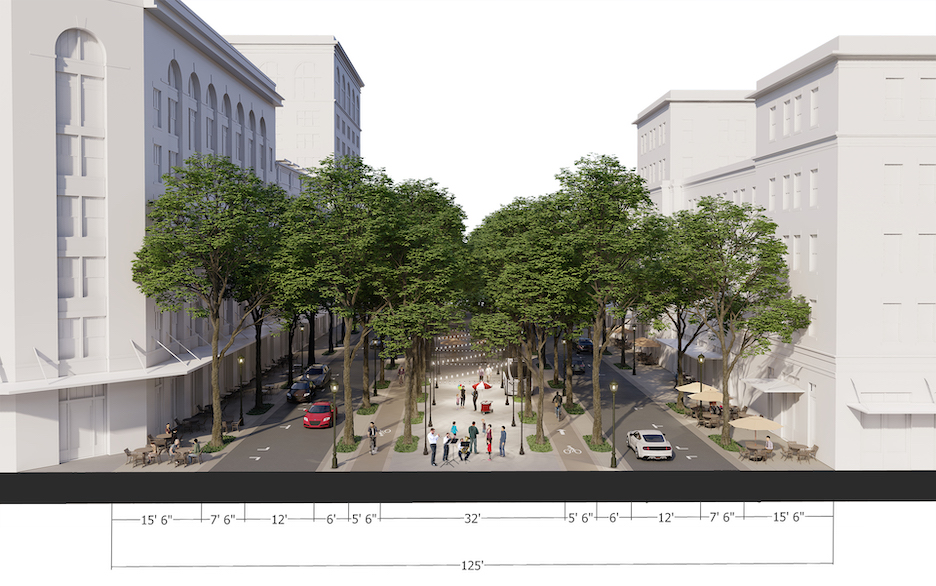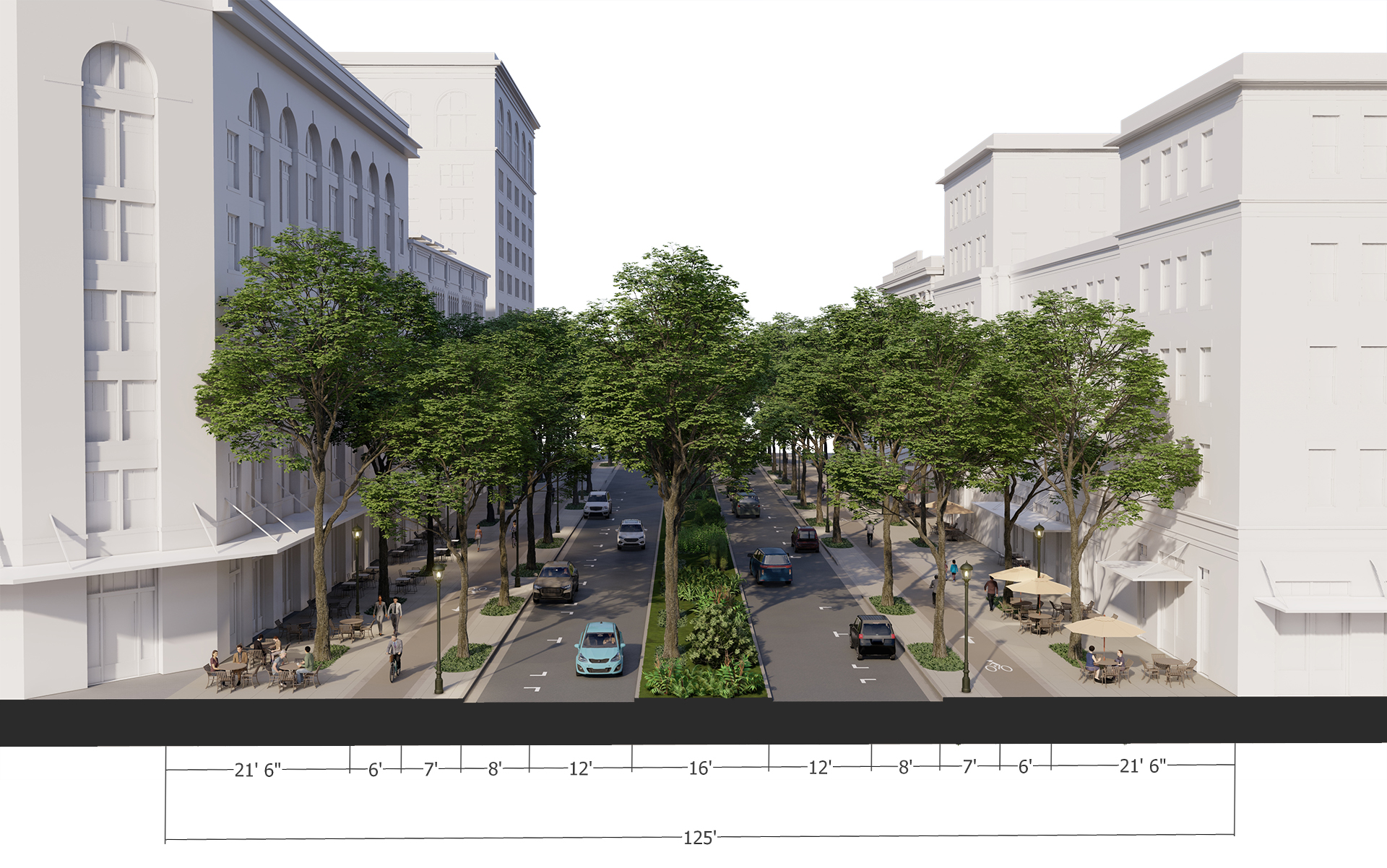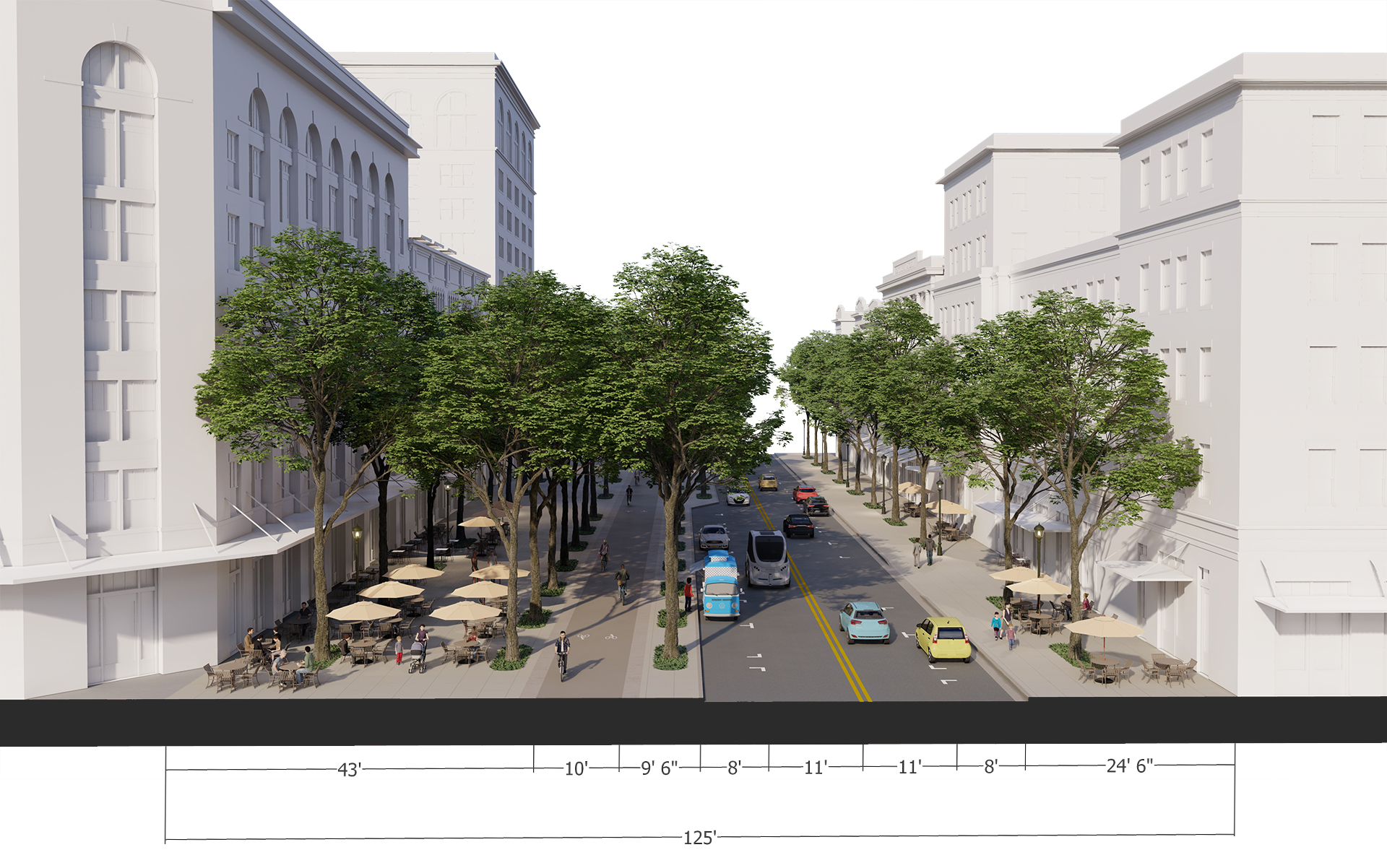Three visions of Broad Street in downtown Chattanooga have emerged from months of study and public feedback around making it safer, greener and livelier, and each see the road narrowed from four to two lanes of traffic.
Wider sidewalks and more outdoor dining along with better bike lanes are common threads through the three draft versions that will undergo more scrutiny in coming weeks, officials said in an interview.
"We have to put something on paper and test it," said Victor Dover, principal-in-charge of the Florida-based design firm Dover, Kohl & Partners, about Chattanooga's effort to reimagine the seven blocks on Broad from the Tennessee Aquarium to M.L. King Boulevard.
Promenade
One vision of the road calls for putting a wide walking space, or promenade, in the center of the road. That area, featuring an array of shade trees, could become full of activity, including cafe seating, art and music, Dover said. He cited The Ramblas boulevard in Barcelona, Spain, as a famous example.
Sidewalks now on Broad would be wider but not by much, Dover said. One lane of traffic would flow each way on either side of the large median, and there would be bike lanes and parallel parking. The road could be completely without curbs, similar to part of M.L. King Boulevard at Miller Park, and provide flexibility to repurpose the space for events, Dover said.
That vision, like the others, could consider Broad as "a park with a street running through it," officials said.
Two broader sidewalks
A second version sees broader sidewalks than now exist on the street, Dover said. A wider median than the current one could be built, but not as big as the first version, he said. Bike lanes would be moved above the curb and integrated into the sidewalk, removing the large existing bump separating cars from bikes, which some call a trip hazard, Dover said.
Officials said that draft, like the other two, could create more bustle along Broad, including housing and 24-hour activity.
One supersized sidewalk
A third vision calls for the supersizing of the sidewalk on one side of the street with park-like features, Dover said. The two lanes of vehicle traffic would be moved to one side of the existing street, he said. That would put traffic going north in a more direct sight line to the aquarium, Dover said. Also, by moving vehicles to one side of the street, there are fewer travel lanes to cross to enjoy both sides of the street.
Dover said both bicyclists and pedestrians could ride and walk within the ultra-wide sidewalk, also providing a lot of space for outside dining and other activities.
Emily Mack, president and chief executive of the nonprofit redevelopment group River City Co., which is overseeing the design work, said any of the versions would still provide access for deliveries to businesses along the street. Also, the shuttle, horse carriages and other public transit would be accommodated, she said.
"All of these must be taken into consideration," Mack said.
The three visions are to go online at broadstreetcha.com, and she said River City and designers are seeking more feedback from the public.
Margaret Flippen, a Dover Kohl senior planner, said officials are "looking forward to hearing community reaction and continuing the dialogue."
She said more than 1,000 Chattanooga-area residents already completed an online survey as part of the planning effort that began in the latter part of 2022, and about 180 people turned out last week for a hands-on design session at the aquarium.
Dover said making Broad Street safer and more welcoming, greener and livelier were the three overarching themes offered by citizens so far, and the design team is building off that input.
Mack said a plan is expected to be ready in spring or summer.
According to officials, parts of Broad could receive different or hybrid treatment depending on the block. For example, the couple of blocks between Aquarium Way and Fourth Street could receive a special rework as an extension of the aquarium plaza, they said.
Also, designers aren't necessarily stopping at M.L. King Boulevard, noting that Broad continues to run to the Tennessee Valley Authority complex a few blocks south. That area has also been identified as one of the possible sites for a new federal courthouse.
Mack said costs related to potential future work on Broad Street would be identified later. Funding options include local, state, federal and private sources, she said.
Also, city and county elected officials will weigh in on whatever design is identified moving ahead, Mack said.
Funding for the Broad Street planning effort is provided by the Lyndhurst Foundation, Benwood Foundation, the city and River City. The cost wasn't disclosed.
Planners decided to take a fresh look at Broad as an outgrowth of the One Riverfront plan finished in 2021 that proposed the biggest remake to downtown's riverfront in nearly two decades.
A takeaway from the One Riverfront plan was that the waterfront district's streets -- especially Broad, Riverfront Parkway and Fourth Street -- aren't perceived as friendly to pedestrians and bicyclists, officials said in 2021.
Broad Street is "a certain candidate for a road diet as it currently carries around 8,000 cars per day but has enough lanes to serve upward of 30,000 cars per day," that plan said.
The plan said 60% of Broad between Aquarium Way and Fourth Street can be characterized by "nonactive frontage," noting the road "is not only overly wide, but it also features nearly full city blocks of blank facades and surface parking lots."
Contact Mike Pare at mpare@timesfreepress.com or 423-757-6318.



